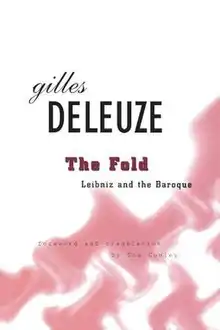The Fold: Leibniz and the Baroque
The Fold: Leibniz and the Baroque (French: Le Pli: Leibnitz et le Baroque) is a book by Gilles Deleuze which offers a new interpretation of the Baroque and of the work of Leibniz.[1] Deleuze argues that Leibniz's work constitutes the grounding elements of Baroque philosophy of art and science. Deleuze views Leibniz's concept of the monad as folds of space, movement and time. He also interprets the world as a body of infinite folds that weave through compressed time and space.
 | |
| Author | Gilles Deleuze |
|---|---|
| Translator | Tom Conley |
| Language | French |
| Subject | Leibniz's philosophy |
| Publisher | Editions de Minuit |
Publication date | 1988 |
| Media type | |
| Pages | 191 pp. |
| ISBN | 9782707311825 |
Influence
The Fold started to influence architectural design and theory shortly after it was published in 1988.[2] Greg Lynn’s guest-edited 1993 March-April issue of Architectural Design, which is titled Folding in Architecture, was one of the first publications that associated Deleuze’s writing on the Baroque with contemporary architecture.[3]
References
- Buchanan, Ian (1994). "Reviewed Work: The Fold: Leibniz and the Baroque by Deleuze Gilles, Tom Conley". SubStance. 23, No. 3 (75): 124–127. doi:10.2307/3685373. JSTOR 3685373.
- Menno Hubregtse, 'Gilles Deleuze’s The Fold: Calculus and Curvilinear Design,' in Handbook of the Mathematics of the Arts and Sciences, edited by Bharath Sriraman (Berlin: Springer, 2020).
- Greg Lynn, ed., Folding in architecture, Architectural Design, vol. 63, no. 3–4 (1993): 1–96.